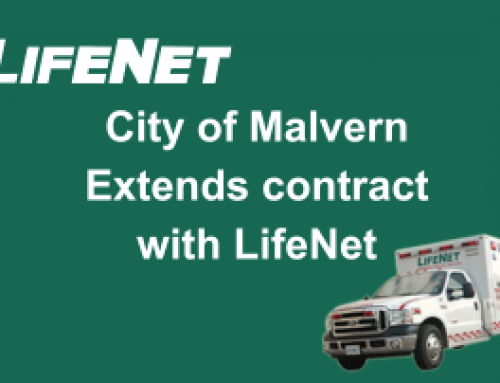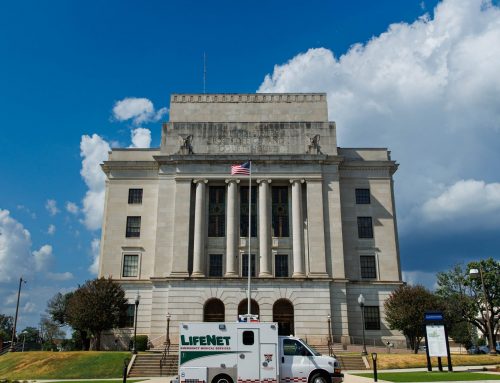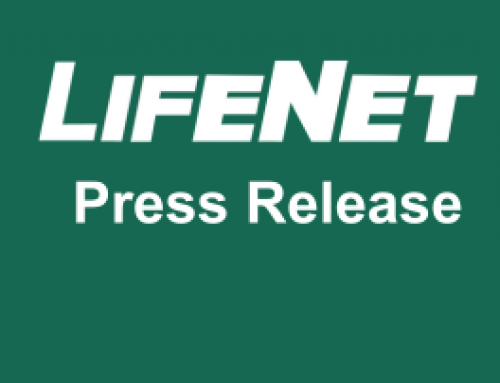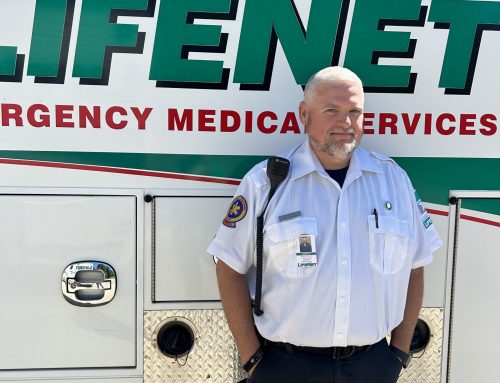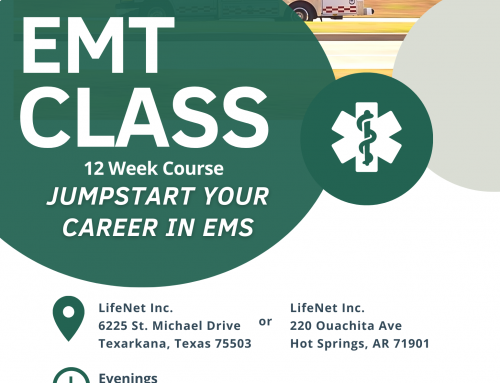Listen to the Radio Interview
Interview Transcribed
JW:
It’s time for a podcast from J.W., Anna, and Friends. Tina from LifeNet is with us this morning.
Besides the fact that it is great weather, it is also national or international, heart day. And the heart is very important, bearing in mind sometimes we overlook it. We do. It’s like, oh, well, we’re alive because it’s beating, and everything’s properly going on. But today is a good day, National Heart Day, to talk about that. And it’s a bigger issue and a bigger problem as far as people having sudden events .
TINA:
A lot of people are surprised to learn that nationally, about 350,000 people suffer a sudden cardiac arrest every single year. Here locally in Texarkana, USA, last year we had 292 people suffer sudden cardiac arrest.
ANNA:
That’s a lot of people. Probably one of my neighbors. When you think about it, we may have known someone who had a sudden cardiac arrest.
JW:
Is that different from a heart attack?
TINA:
Yes.
Sudden cardiac arrest is an electrical issue where the electrical activity stops in your heart. It literally is just what it says. It comes on suddenly without any warning. So it’s an electrical activity issue. We have to shock the heart to make that electrical activity get back to normal and do chest compressions, or what we call CPR, to get that the muscle memory in the heart to start pumping again. There’s a little bit more behind that. We will talk about that in a little bit.
A heart attack is actually a plumbing issue. Sudden Cardiac arrest is an electrical issue, and a heart attack is plumbing. In a heart attack, the arteries that are pumping blood get clogged, and we have to get those unclogged.
JW:
I’m thinking a quick question from an ignorant standpoint here. Is there a way to tell if somebody is having a heart attack or a sudden cardiac arrest?
TINA:
There are signs and symptoms of a heart attack. But in sudden cardiac arrest, there are no symptoms. You and I could be talking right here, and I could fall out in front of you. Suddenly, I’m unresponsive, not breathing, and I don’t have a pulse. There was nothing that came on prior. I didn’t have the chest pain and other things that you often hear about with heart attack.
JW:
It just happened, huh?
TINA:
Yeah. Hence the name Sudden. So that’s the key.
JW:
You recommend businesses to have these devices. Can you tell us more.
TINA:
Studies have found that nine out of ten people who get a shock by an AED, which is an automatic external defibrillator, nine out of 10 people who get that shock within the first minute, survive their sudden cardiac arrest. The American Heart Association recommends, I believe it’s within three minutes of somebody witnessing somebody going into sudden cardiac arrest, that you get an AED on them.
JW:
So three minutes isn’t a lot of time.
TINA:
No. And so anywhere where there’s more than one person or there are multiple people working in a building, a church congregating, anywhere, we recommend that you have an AED. We actually recommend the Zoll AED Plus. We recommend it because it interacts with our cardiac monitors. It’s going to coach you through how to do CPR. It’s going to tell if your chest compressions are deep enough. It’s going to tell you if you’re pushing fast enough. All those things. It’s a wonderful device. And if you’re a nonprofit, we have a matching grant program. So we’ll pay for half the AED. You pay for the other half.
ANNA:
Oh, please, please accept that help. They’ll pay for half of it, right?
TINA:
For a nonprofit. If you’re not a nonprofit, and you still are interested in getting the AED, you can buy them directly through us at our cost.
JW:
We’re talking about Heart Day. Do you have videos and courses and things that you can train people with?
TINA:
We do. One of our goals is to have every person in the community trained on bystander CPR. For those who aren’t familiar with this, it is simply learning how to do chest compressions. If you witnessed somebody going into sudden cardiac arrest, and you haven’t been properly trained through a full three hours certification course, you can do bystander CPR. The American Heart Association has done studies. What they have found is so long as you’re doing good quality chest compressions for about the first 20 minutes, there’s enough oxygen in our blood to keep the cells alive and prevent cellular death. That’s why we’re pushing really hard for people to learn bystander CPR.
You no longer have to do the mouth to mouth, if you don’t know how to do the rescue breath.If you’re trained in it and you feel comfortable doing it, fantastic. But the studies have actually found that whether you do rescue breaths or not, in adults and older children, 12, 13 years old, those older kids, everything we just talked about is true. Younger kids, you still have to do rescue breathing.
On our Facebook page today, there’s a link to a two minute video where the American Heart Association teaches you how to do chest compressions or bystander CPR. We also do free classes. We will come out to your church, your civic club, or any organization for 10 or more people, and we will do the class for free. We will teach you how to do chest compressions, how to use an AED.
JW:
Well, I’ve seen those AED devices in schools and places like that, and I just I wasn’t quite sure what they were used. You got me educated between the difference between a heart attack and sudden cardiac arrest. So I’m much smarter than I was before you got here. Talk a little about LifeNet and the membership that you’ve got. Talk about the idea that people can get a membership for ground and air transport.
TINA:
So in our Texarkana Division, we have both ground and air memberships. And basically, if you purchase a membership, not only does it help support LifeNet in the community, but it also helps you financially if you’re ever transported. With a membership, if you don’t have insurance, or if your insurance denies your transport for any reason, we’re going to reduce your bill by 40 percent. So that’s a good savings. And on top of that, if you have insurance or Medicare and they pay anything, even a penny, you’re not responsible for anything else. So we we accept their payment as payment in full. If you have Medicaid, you don’t need a membership. Memberships start at $75 dollars a year for ground only, $90 a year if you just want air only. If you want ground and air coverage, it’s $135 a year. Our air membership covers if you ever had to be transported on our helicopter or on our fixed wing plane, both based at the airport here (in Texarkana).
JW:
You may have said it and I may have missed it. Does that cover like if there’s a husband and wife?
TINA:
It covers your entire household. If also covers your guest if you have a guest. So let’s say you’re grandparents and your grandkids are visiting for a week, and they have to be transported from your house. They’re covered. Now it doesn’t cover the plumber who might be working at your house and gets injured.
JW:
I gotcha. What else have I missed here? I know I’ve missed something.
TINA:
You know, I think the most important thing as far as it’s related to Heart Day is don’t be scared. If you witness somebody that goes into sudden cardiac arrest.
ANNA:
It would scare me.
TINA:
Our dispatchers are going to walk you through how to do CPR. Remember that you are their lifeline. Their heart stopped beating and they’re not breathing. Anything you can do for them in that moment is better than doing nothing at all. So don’t be scared and know. that at the end of the day, national survival rates are only about 10 percent. Our survival rates are higher.
ANNA:
Perfect.
TINA:
One of the best ways to improve the survival rates is for more people to be willing to step up and do that CPR. So don’t be scared. Just do the very best that you can to save somebody if you witnessed them going into cardiac arrest. If you haven’t been trained, let us know. Go watch those videos the American Heart Association has put out. And if you just want to call us and set up a time to just come by, I have dummies in my office that we can practice.
ANNA:
There’s another important key, and that is preventative heart care. So see your physician. Uf you’re feeling not well, see your physician. Just from a layman’s point of view. It never hurts to be have preventative health care.
JW:
Tina, if somebody wants some information on what we talked about this morning as far as the device or getting in and on the program or anything like that or getting a membership, what do they need to do?
TINA:
LifeNetEMS.org is our website. They can call 903-556-0301, and that’ll go to me directly.


